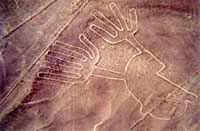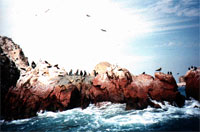Between 200 B.C. and 600 A.D., a civilization flourished in the area that is presently known as Nazca. Located on the southwestern desert coast of Peru, scientists and historians have been unable to explain the reason for the huge trapezoids, triangles, rectangles, and quadrangles that stretch across miles of desert plain. One such scientific researcher, Maria Reich, was a mathematician who studied these finds from the 1940's until her death in 1997. The theories for these mysterious geoglyphics left behind by the Nasca Indians range from reading of the constellations, weather forecasting, and even ancient landing strips for space ships from another planet. The later of the hypotheses was popularized in a 1970's in a movie "The Chariots of the Gods."
We may never find the true reason for these incredible pieces of art that are just as mysterious as the civilization that made them. Our ability to get a birds eyes view, such as the ancient visitors may have, lets you form your own idea on their purpose to the Indians of the Nazca plain. |
 |
 |
Located in the area of Paracas National Park is a pre-Inca cemetery dating back 3000 years. Here you can view the remains that have been preserved by the deserts dry air. Just up the road, by the seaside, you can get a spectacular view of the marine and animal life. You may see: Seals, Sea Otter, Sea Lion, Leatherback and Green turtles, Lizards, or a variety of more than 18 regional bird species. |
|